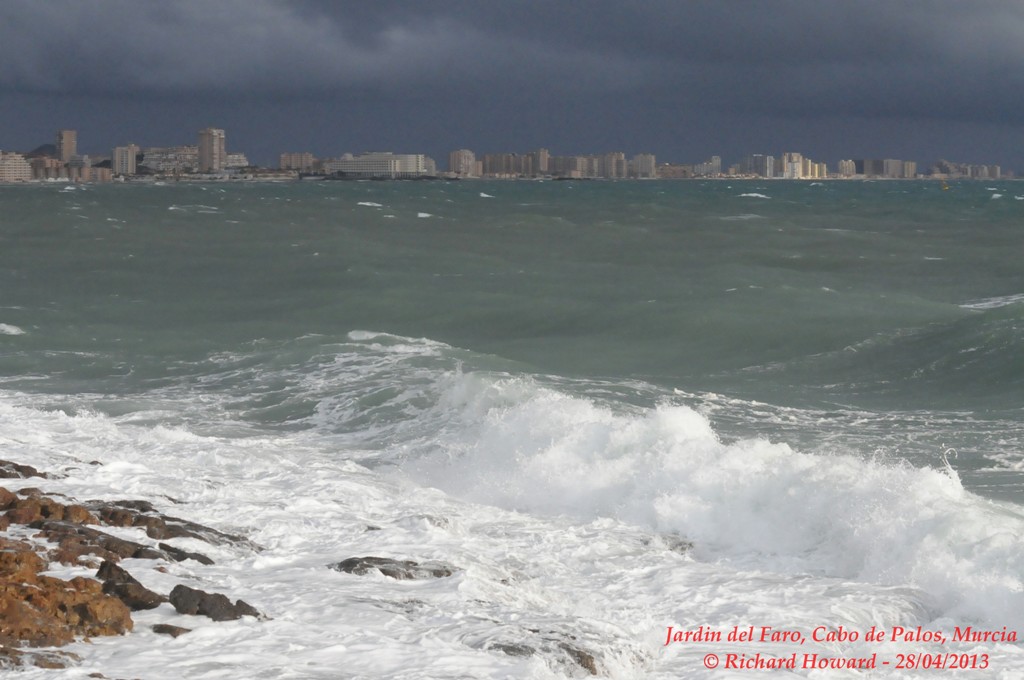Hi all,
Over the past few days, the weather has broken with a ridge of low pressure and associated weather fronts crossing the western Mediterranean. This has had the effect of pushing many more easterly migrants into the eastern seaboard of Spain, mainly from Tarragona northwards, with for example a minimum of 8 Collared Flycatchers being seen on the 28th and 29th April. (For more technical details of this, see http://rarebirdspain.blogspot.com/2013/04/invasion-de-papamoscas-collarinos.htmlwww.rarebirdspain.net/). Murcia has had its share but not of such rare birds, with White-winged Black Terns being located on the 28th at San Pedro del Pinatar Salinas (2 birds), and a further White-winged Black Tern at the EDAR (sewage farm) of Cabeza Beaza, Cartagena on the 29th and 30th and Wood Warbler at Calblanque (Los Belones) also on the 29th.
Since my last report, I have been to the Cabo de Palos lighthouse garden each morning, and the number of migrants there have certainly picked up.
On the 28th, I had 5 Redstarts, 8 Willow Warblers, 2 Turtle Doves, a Bee-eater, 6 Northern Wheatears, Woodchat Shrike and a couple of Common Whitethroats and a Nightingale singing.
As you can see, not the ideal weather for birdwatching...
... just a matter of time before 'rain stopped play'
One of the few photographable birds, Northern Wheatear
On the 29th , with Mick Brewer, the Nightingale was still there singing away, and we had Whinchat, Spotted Flycatcher, 2 Common Whitethroat, 2 Pied Flycatcher, 2 Woodchat Shrikes and single Redstart and Chiff/Willow.
A selection of the birds seen at the lighthouse garden today (29-04-2013), from top to bottom
Pied Flycatcher, Little Egret, Woodchat Shrike, Pied Flycatcher, Spotted Flycatcher and Common Whitethroat
On the 30th there were more Pied Flycatchers
Other outings of interest during the past 3 days have been to Calblanque (Los Belones) on the 28th when I went down to the arboretum next to the beach car parking area. This is normally a favourite area for flycatchers when they are around, and I wasn’t disappointed, seeing a minimum of 8 Pied Flycatchers. Also there, 5 Turtle Doves and a single Chiff/Willow, but I had to give up after half an hour as the rain started to fall, and it didn’t look like it was going to stop anytime soon!
In the afternoon of Monday 29th April, having heard that there had been several Wood Warblers seen in the south-east of Spain, I thought I’d try my luck and I again went to Calblanque, now with the weather more settled (almost clear skies and little wind). In the arboretum there were only 2 Pied Flycatchers remaining, but in the course of the afternoon I had 4 Spotted Flycatchers, 5 Woodchats, Common Whitethroat, Black-eared Wheatear, and in the second spot where I thought a Wood Warbler might lurk, there was one, feeding in a large tamarisk bush.
There had obviously been a fall of Spotted Flycatchers...
...but for me, the bird of the day...
...was this very obliging Wood Warbler
...which allowed me to take its photo
At one of the puddles in the track, I came across this Cattle Egret
I continued my afternoon’s birdwatching at the Salinas at Marchamalo (Cabo de Palos, off the RM-12 behind the go-kart track). There is a large area of bushes there with a number of tamarisks, and I have seen Wood Warblers there in previous years. Today it was not to be, but I did have a couple of Willow Warblers and another couple of Bonelli’s Warblers there.
In the afternoon of the 30th I wasn’t quite sure where to go – I fancied seeing White-winged Black Tern as I can’t remember having ever seen a spring, full breeding plumaged bird before. I knew that 2 had been seen at San Pedro del Pinatar two days ago, and one at the EDAR (sewage farm) in Cartagena yesterday, so which to go for? In the end I decided on the San Pedro birds (which may have been a mistake as I didn’t see them and later found out that the Cartagena bird had still been there). At San Pedro were all the ‘usual suspects’, waders being Redshank, Turnstones, Sanderling, Kentish Plovers, Common Sandpiper, 5 Curlew Sandpipers, 8 Little Stints, Stone Curlew plus numerous Avocets and Black Winged Stilts. Terns were represented by Common, Gull-billed, Sandwich and Little Terns. Passerines of interest were Reed Warbler, Common Redstart and a female Pied Flycatcher, and in the base of the reedbed at the entrance to the Salinas on the right, a male Little Bittern.
Chauu!!



+copy.jpg)
+copy.jpg)
+copy.jpg)
+copy.jpg)
+copy.jpg)
+copy.jpg)









Muy buenas fotos...un abrazo desde Murcia..o sea..muy cerquita....
ReplyDelete